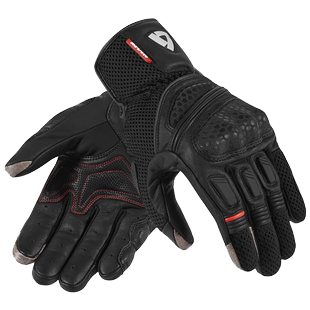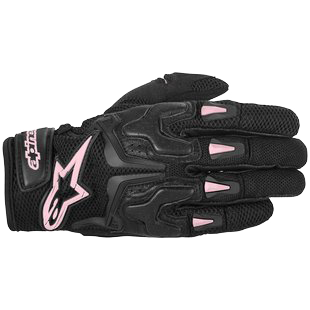There are a ton of different motorcycle glove options out there for us to pick from, but what features make a good adventure or dual sport glove? I will break down some of the common features in motorcycle gloves and you can use this article as a guide to help you find a glove that suits your needs.
Sport and Race Gloves
Cuff length
- In sport and race gloves you will find plenty of long and short cuff gloves. True track day and race gloves are typically full gauntlet gloves. They are built this way to provide additional wrist protection and to make sure the sleeve and glove overlap so no skin is exposed in a crash. Full gauntlet gloves are more protective than short cuff gloves, but they are also warmer and sometimes more than people want to deal with. That’s where the short cuff gloves hit their mark. With short cuff gloves you sacrifice a bit of protection for comfort.
Abrasion Resistance
- Sport and race gloves need to be highly resistant to abrasion. Higher speeds and pavement need very tough fabrics. You will see exotic materials in this genre of gloves. Even the leathers will often be a mix of different kinds. For example, Held gloves always use Kangaroo leather in the palms. Kangaroo is tougher than cowhide so the palm can be thinner and provide better feel of the bars without sacrificing any protection. Other less common leathers you may see are stingray, pittards, goat, and deer.
Made To Slide
- The best sport and race gloves are made to slide in case of a crash. Cheaper gloves will have very little protection in the palm and wrist and this can lead to more broken wrist injuries. If you put the heel of your hand down in a crash and your glove does not slide the momentum of your body will break your wrist. If your glove is designed to slide you will still be protected and reduce your chances of wrist injury. Materials like Superfabric are very good to promote sliding.
Armor
- It is common to see armor built in to the knuckles and fingers of sport and race gloves. The most common materials are carbon fiber and different flavors of thermoplastic. Titanium is another material used in the knuckles of some high end gloves. When it comes to knuckle armor some people may have difficulty with the fit. If you have large knuckles the hard protectors may not be comfortable. If you have large knuckles you may want to find a pair of gloves with a floating piece of knuckle armor.
Waterproof
- True sport and race gloves are rarely waterproof. There will be some gloves that blend sport and race features into waterproof gloves, but in my opinion the gloves should be classified into the touring category at that point.
Specific Protections
- There are some other specific protections you will find in some sport and race gloves. For example, some gloves have the pinky and index fingers sewn together. In a crash another common injury is a broken pinky finger. It happens when the pinky gets separated from the rest of the fingers during a slide. Manufacturers are also starting to make thicker padding in the heel of the hand and leaving a space in the middle of the padding. That space is to help prevent damage to the scaphoid bone in the wrist.
Comfort
- Common comfort features you will find in sport and race gloves is perforation for air flow, stretch panels for easier movement, and thin palms for better feel of the bars.
Touring Gloves
Cuff Length
- Touring gloves have plenty of short cuff and gauntlet options. Full gauntlets do offer more protection, but in the touring category they are much more important for cold weather and waterproof gloves. For cold weather the full gauntlet glove can overlap your sleeve and keep the cold air from going up your sleeve. For wet weather you want your gauntlet to tuck into your waterproof shell so the water doesn't run down into your glove and soak it from the inside.
Abrasion Resistance
- Abrasion resistance is still important to touring gloves and while leather is still a common material, you will also see more fabrics like ballistic nylon and mesh in this category. You typically don't see as many features to promote sliding in touring gloves, but there are some options out there that pull in a lot of race glove features.
Armor
- You will see the same types of armor in touring gloves as you see in sport and race gloves. Hard knuckle protectors and thermoplastic is common, but there are also many offerings in the touring category with less of this armor.
Waterproof
- The best waterproof gloves will utilize Gore-Tex, but there are other products like Hipora that work well and save some money. Pay close attention to the construction of waterproof gloves. Liners on the inside can be hard to get on and off and will allow the shell of the glove to soak. If they soak, not only will they be heavy, your hand will be surrounded by cold water. Even if that cold water can’t get through the waterproof membrane it can certainly make your hands very cold. The ideal construction would have the waterproof membrane on the outside of the glove or bonded to the shell from the inside. Gore-Tex X-Traffit is a glove construction that offers these features.
Comfort
- Touring gloves will have comfort features optimized for the seasons. Very few gloves are comfortable for four seasons. For hot weather you will find more mesh materials to flow air or perforated leather. For cold weather you will often see thinsulate insulation and breathable membranes to keep your hands from soaking the gloves in sweat. The palms in a touring glove may feature extra padding such as gel or memory foam to help absorb bar vibrations that can cause discomfort on long rides.
Offroad and Dirt Gloves
Cuff Length
- Offroad and dirt gloves typically feature short cuffs. Speeds are often slower than street and you are more likely to slide in dirt. These gloves are all about being able to move around.
Less Abrasion Resistant
- Since speeds are slower, offroad gloves often feature more materials meant for comfort than long slides on the pavement. You will see a lot more textiles in these gloves and the ones that do use leather will feature softer suede type leathers. They hold up well for offroad purposes, but the pavement will make quick work of most offroad gloves.
Waterproof
- Offroad gloves are not usually waterproof.
Flexibility
- The lightweight textiles and leathers in these gloves are all about airflow and movement.
Adventure and Dual Sport Gloves
Cuff Length
- Most cuffs are short for dual sport gloves. You can find some that are full gauntlet, but when riding offroad the short cuff is much easier to deal with. I would suggest a short cuff for a dual sport glove and carry a waterproof glove that offers a full gauntlet in your bag.
Abrasion Resistant
- Since dual sport riding still includes a lot of pavement you need a glove that is tough enough to hold up in a slide. You will see design features such as hard knuckle protectors and some gloves even offer fabrics in the palms to promote sliding. Leather palms are one of the best materials for dual sport gloves.
Waterproof
- There are some dual sport gloves that are waterproof, but they are less common. Even in moderate temperatures, when you start working hard offroad a waterproof membrane may become too warm. Many dual sport riders will carry a separate set of waterproof gloves if needed and they often come from the touring category. The short cuff is a more flexible option when transitioning between street and dirt.
Flexibility
- This is a real balancing act with a dual sport glove. You want to ease of movement you find in a dirt bike glove, but you also need the durability you find in a street glove. Pay close attention to the design of the glove. The best gloves will often feature some textiles for movement and they will reinforce the impact zones and palms with heavier materials like leather. Even the armor options in a good dual sport glove are often redesigned to provide protection with a more malleable feel.
Unfortunately, for our lady riders the glove picks for adventure and dual sport options are pretty limited. There is a much better selection in the other categories, but I do have a suggestion for the ladies. Check out the Alpinestars Stella SMX-3 glove. It has a nice blend of the features I have mentioned above for the adventure and dual sport category.
As you can see there is a plethora of options and features to consider in motorcycle gloves. We all ride in different environments and at different levels so the glove I would pick may or may not be the glove that is best for you. I would encourage you to consider the different features I mentioned above and write down the ones you want. Then prioritize that list and look for a glove that fits your list. Don't be afraid to spend a little money on these gloves. Just think about how useful your hands are. The good gloves will likely last you for many years unless you go crashing in them all the time. If you do that, you definitely need good gloves.






